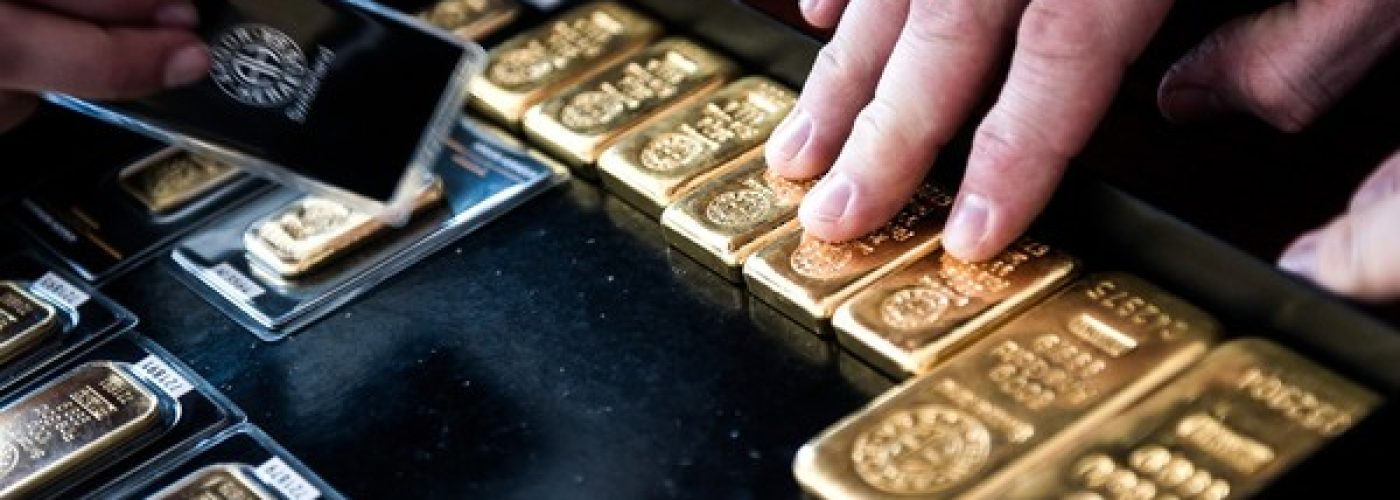 ©Bloomberg
©BloombergGold has been having one of its moments since the beginning of the year; the dollar price is up over 15 per cent, compared with 1.9 per cent for the S&P 500. At these levels, the metal is overpriced and well worth it.
By “overpriced” I mean that market sentiment is measurably too bullish.
Perhaps, though, Mr Market is on to something. In the olden days, when Deutsche Bank was a cornerstone of German stability, you could count on the dealers on its gold desk, along with their friends working for the other big banks, to step in and make sure that the market was liquid and continuous.
On Thursday, though, Deutsche sent a letter to a federal judge in New York agreeing to settle a lawsuit that accused it of conspiring with other big banks to manipulate the gold and silver markets. As part of the settlement, Deutsche agreed to provide “valuable monetary consideration to be paid into a settlement fund” as well as “co-operation in pursuing claims against the remaining defendants.” Those defendants include Scotiabank, Barclays, HSBC and Société Générale.
This cannot make it easy for the remaining members of the Old Boys Club to have a friendly conference call about reducing the magnitude of swings and roundabouts in the bullion price.
Back in March of last year, the twice-daily, phone-based London gold fix was turned into a more compliance- and algorithm-friendly electronic system. At the same time, capital and cash liquidity requirements were forcing the global systemically important banks to reduce their commitments to high-volume, low-margin enterprises such as precious-metals trading.
The combination of reduced transparency and the scarcity of dealer capital has, arguably, led to even lower bid/ask spreads and higher volatility. Also, the higher compliance burden seems to have driven more gold trading into the shadows.
As one Swiss gold refiner I know puts it: “For the parallel markets [black markets], this is party time. The parallel markets are now faster and more flexible. This is very, very dangerous, because the liquidity for these markets comes from sources that are illegal. But I cannot take a small customer, such as somebody who is doing 15 to 20 kilos a week, because my compliance costs are too high.”
Think about that: a “small customer” who refines only $30m of gold annually, and who is now gravitating to the “parallel market”. Since after a couple of refining runs, at most, it is virtually impossible to tell the origin of one piece of gold from another, you get an idea of how much gold is moving from one compliance-unfriendly owner to another. Especially since the developed world’s tax and banking systems are ever less open to bleaching soiled money.
This hidden demand dynamic can explain part of the increased investor interest in gold. Also, one of the classic arguments against gold, its nonexistent yield, is rather less compelling in a negative rate world.
Even so, while it would seem that the gold price is in a multiyear uptrend, many people like to be paid to wait, even if they are not paid much. That explains the increasing popularity of the gold “streaming” equities, which effectively pay dividends out of their income from secured lending to gold mining companies.
Among the best managed of the gold streamers is Franco-Nevada, which has a dividend yield of about 1.25 per cent. This is not an undiscovered story. Since the start of the year, Franco-Nevada’s stock has risen nearly 47 per cent.
Franco-Nevada’s chairman, Pierre Lassonde, spoke at the spring investor conference run by Jim Grant, the US writer, last week. Mr Lassonde made the case (or preached to the choir, if you will) about the opportunity clueless central bankers are handing to gold investors. “We think the ECB’s negative interest rate policy has the potential to double the size of the gold-bar market in Europe,” he said.
That sounds rather expansive, but my Swiss refiner already sees it in his business. “Europeans are buying bars and coins as a personal hedge to protect themselves against the currency war.”
Recently, there seems to have been an undeclared truce declared among central-bank combatants in this undeclared war, but truces have a way of falling apart. Consider the possibility that one of the systemically significant banks should need a co-ordinated bailout due to its inability to control the risks of its derivatives book. Could this lead to even more heroic quantitative easing than we have seen so far?
As Mr Grant says: “Radical policy begets more radical policy.” Maybe gold is not overpriced enough.
Copyright The Financial Times Limited 2016. You may share using our article tools.
Please don’t cut articles from FT.com and redistribute by email or post to the web.





